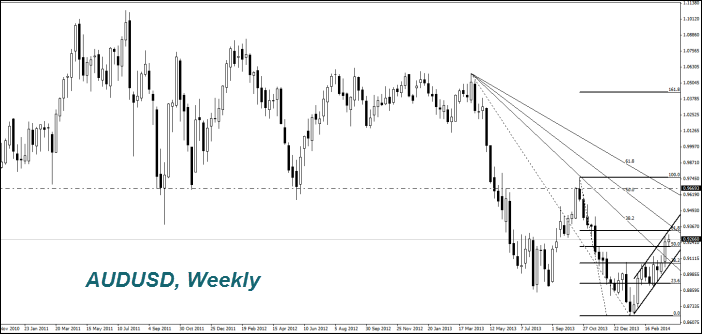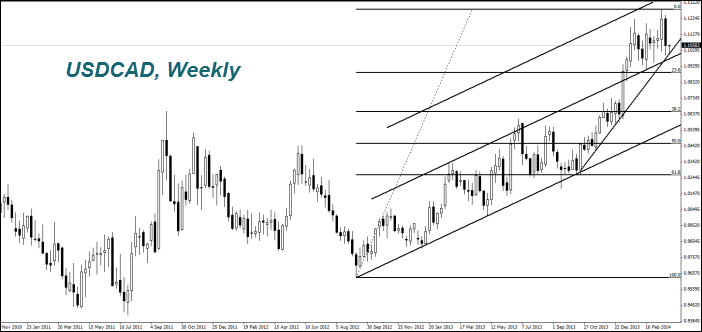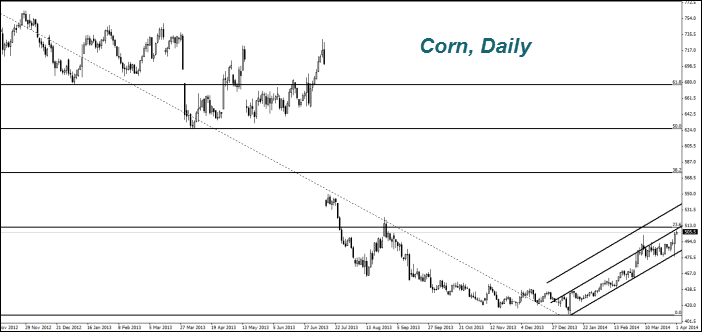The U.S. Dollar Index was corrected downward on Monday. The Chicago (PMI) for March was much weaker than expected and amounted to 55.9 points. In addition, the Fed Chairman, Janet Yellen said the U.S. economy still needs support from the Fed. Market participants decided that the soft monetary policy may be continued. This reduces the chances for the next contraction in the QE or the asset purchasing program at the next Fed meeting on April 30 as well as a negative impact on the U.S.Dollar. Note that the U.S. regulator has its step taking associated with the unemployment level and considered the level 6.5% acceptable. Because of this, the U.S. labor market data on Friday may strongly influence the currency market. Today, investors will monitor the ISM Manufacturing for March, which will be released at 16-00 CET. In our opinion, the preliminary forecast (54 points) is a positive for the U.S. currency.
Despite the weakening USD, the rising (EURUSD) was limited yesterday by the negative inflation data for March. It was the lowest since November 2009. Theoretically, this could prompt the ECB cut interest rates to prevent deflation at its next meeting this Thursday. Recall that the consumer price growth of less than 1 % was observed for six consecutive months. Today, at 9-55 CET and 10-00 CET EU we will see the important data on: Unemployment in Germany and the EZ PMI Manufacturing. They can affect the Euro if they differ markedly from neutral predictions.
The RBA kept the interest rates at 2.5% today, as expected. However, its representatives said that the Australian Dollar (AUDUSD) is too much appreciated (increased) lately. Market participants do not pay much attention to it. They expect important economic data from Australia. On Wednesday at 5:30 CET, the real estate market figures are expected to come out. On Thursday at 2-30 CET, we expect more important indicators: Retail Sales and the Trade Balanc . In our opinion, the preliminary forecasts are moderately negative for the Australian Dollar and may cause a downward correction.
As it was expected, the Japanese Tankan economic indicators were worse than the preliminary forecasts. Today, the sales tax in Japan gets increased from 5% to 8%. All of it may cause a further weakening of the Yen (it looks like growth on the USDJPY chart). The next important economic data will be released in Japan on Wednesday.
The Canadian Dollar strengthened yesterday (fall on the USDCAD chart) after Canadian GDP growth in January that exceeded forecasts and compensated the decline in December. Today at 14-30 CET in Canada we will see the Industry Price Index and the Manufacturing PMI at 15-30 CET. We believe that the predictions are in favor of the Canadian dollar attenuation (increase in the chart).
Yesterday, the USDA released a quarterly report. The ( Corn ) prices rose to a 6- months maximum. Its reserves in the United States amount to 7,006 B tons - less than expected. Corn acreage this year are at the lowest level since 2010 and amount to 91.7 million acres. Inventories of soybean (Soyb) were minimal in 2004 and amounted to 992.3 million tons, more than expected. Its quotes have also increased. The stocks are significantly less than last year level, 998 million tons. Probably some of the market participants did not expect a rise in the Soyb price. Several negative forecasts from major companies appeared today. In particular it is noted that the crops of soybeans in the U.S. increased to 81.5 million acres from 76.533 million last year and there will be no lack of beans. The Wheat prices fell yesterday. Its reserves were 1.056 billion bushels. This is more than the expected 1.042 billion bushels. The Wheat crops in the U.S. decreased by 1% compared to the previous year and amounted to 55.815 million acres. Overall, the first quarter of this year was the best for the commodity futures market over the past six quarters.
This overview has an informative character and is not financial advice or a recommendation. IFCMarkets. Corp. under any circumstances is not liable for any action taken by someone else after reading this article.
Recommended Content
Editors’ Picks
EUR/USD clings to gains above 1.0750 after US data

EUR/USD manages to hold in positive territory above 1.0750 despite retreating from the fresh multi-week high it set above 1.0800 earlier in the day. The US Dollar struggles to find demand following the weaker-than-expected NFP data.
GBP/USD declines below 1.2550 following NFP-inspired upsurge

GBP/USD struggles to preserve its bullish momentum and trades below 1.2550 in the American session. Earlier in the day, the disappointing April jobs report from the US triggered a USD selloff and allowed the pair to reach multi-week highs above 1.2600.
Gold struggles to hold above $2,300 despite falling US yields

Gold stays on the back foot below $2,300 in the American session on Friday. The benchmark 10-year US Treasury bond yield stays in negative territory below 4.6% after weak US data but the improving risk mood doesn't allow XAU/USD to gain traction.
Bitcoin Weekly Forecast: Should you buy BTC here? Premium

Bitcoin (BTC) price shows signs of a potential reversal but lacks confirmation, which has divided the investor community into two – those who are buying the dips and those who are expecting a further correction.
Week ahead – BoE and RBA decisions headline a calm week

Bank of England meets on Thursday, unlikely to signal rate cuts. Reserve Bank of Australia could maintain a higher-for-longer stance. Elsewhere, Bank of Japan releases summary of opinions.


